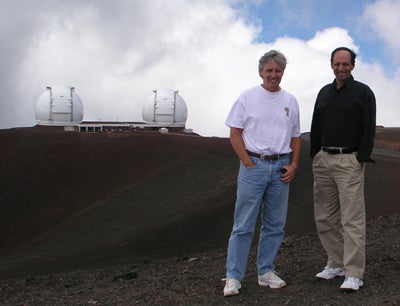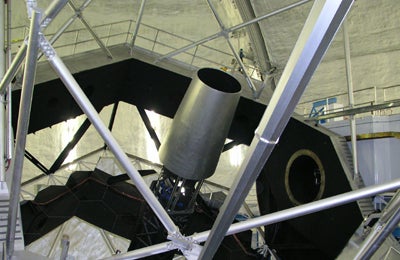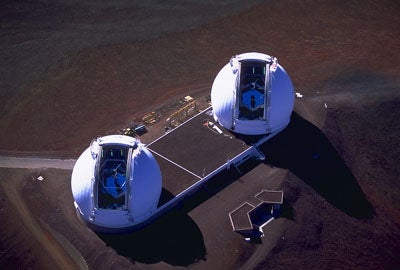As our airplane swoops down towards the big island of Hawaii we get our first glimpse of the enormity of Mauna Kea. Yes, the beaches look beautiful and the sunlight on the water is dazzling, but at nearly 14,000 feet and home to the world’s largest optical and infrared telescopes, Mauna Kea is the sole object of our desire. My partner, Jeff Patino, reminds me that it is really the tallest mountain in the world because its base reaches another 18,000 feet under the vast blue ocean that surrounds it. The Hawaiians say this mountain is sacred. I think to myself everything sacred runs deeper than we perceive.
We leave our hotel by the balmy beach and drive to the Keck headquarters about 20 minutes away in Waimea. At 2,800 feet it is already appreciably cooler. Still about a two-hour drive and nearly 11,000 feet below the observatory, this is where most of the scientists using the Keck telescopes actually do their observing. As we enter the low-profile, high-tech building, we are greeted warmly by Laura Kraft, Keck’s public relations director. She gives us a brief orientation and introduces us to Ron Laub, the Director of Special Projects who will be taking us up in a Keck four-wheel-drive vehicle to the facilities on the top of the mountain. Ron is a veteran scientist who worked on the Keck during its construction and knows every imaginable detail about the facilities and telescopes as well the surrounding countryside. Already, I know it’s going to be a great drive.
As we gather our gear, we are met in the parking lot by the world-famous planet hunter, Geoff Marcy. We are surprised and delighted to learn that he will be joining us on the drive and our tour of the observatory. While I expected him to be brilliant (he is) I somehow did not imagine that he would be so friendly and engaging. Here is a guy with a million complex thoughts on his mind but he took the time to show genuine concern about our travels, families, and projects.
As we ascended the huge dormant volcano and the thin winding road took us through old lava flows and magnificent scenery, our talk turned increasingly to the telescopes we were about to see and the cutting-edge work of Marcy and his team.
Somewhere around 9,000 feet we take a break at the Onizuka Center for International Astronomy for lunch. Ron says it will give us a chance to get acclimatized if we actually stayed long enough. I realize we won’t be doing that when Ron gives us a technique to avoid shortness of breath and dizziness at the summit. Back in the car, the road above the lodge turns to dirt. Now above the clouds, the sky, with only a few high wisps of cirrus, looks pretty clear. Finally we reach the last set of switchbacks and we start to see some of the thirteen observatories that dot this stark mountaintop. I am struck by the amount of equipment and building material that had to have been hauled up that small road over the years. I notice that the Keck, with its two large telescope housings, is not at the very peak but just off to the west of the group. Some of the other buildings are shinier or a little higher but the Keck is clearly the largest.
Hopping out of the car we find the air to be about 40 degrees Fahrenheit, about half the beach temperature 13,600 feet below. And now that we are above half the atmosphere, the air is noticeably thin.
After touring the high-tech control room, we walk down the long hallway to Keck I and take an elevator that lifts us up and lets us off on a platform about four stories up inside the eight-story spherical room containing the telescope. Here it is only about 20 degrees Fahrenheit because they try to keep the temperature near the previous night’s low. It’s chilly!
But it is not the temperature that has our attention — it is the size of the telescope and the amount of special equipment around it, which fills the whole room. The platform we are on is about level with the mirror. At first I do not realize it is there, because from our angle it simply and perfectly reflects the equipment and wall on the other side of the room.
Soon we hear a loud, official “beep” and things start moving. The walls are turning, the telescope is slewing both vertically and horizontally, and my mind thinks the platform upon which we are standing is moving. Still, the telescope is surprisingly quiet and remarkably fast. The 10-meter parabolic mirror, made of hexagon panels with a one- or two-atom-thick coating of aluminum, is spectacular to watch. What a show!
Geoff and Ron try to tell me about what all the different equipment is used for: some for filtering, some for infrared purposes and some strictly for viewing galaxies. It is all so amazing and no doubt tremendously expensive I think as I carefully try not to bump or touch anything. We took a lot of pictures but none can capture the entire telescope in one view nor can they do justice to the feeling that comes from seeing the telescope in action. You have to go there and see it for yourself.
After touring a few more rooms — the large area that houses the interferometer, where they can merge the light from the two telescopes when they are synchronized, and the spare mirror room, where we had a lot of fun taking pictures in the immaculate reflections — we head for the roof top. We snap a few more pictures of the telescopes with mountains and clouds in the background, but then, alas, it starts snowing. That’s our clear signal to get back to the car and head down the hill.
Back in Waimea that evening, we have dinner with Geoff and Ron and recap the day. I have a million more questions about Geoff’s work and his exciting discoveries, but I already have a much greater appreciation for his tools: the largest optical and infrared telescopes in the world!
All day we look forward to seeing Geoff again and meeting some of his team members at the Keck headquarters. I hope to have a chance to ask him about the dynamics problem we are working on at the Binary Research Institute (my day job) but we also just want to see Geoff in action.
We arrive about 9 p.m. Geoff has already scripted out the evening with a plan to minimize slew time and hopefully observe about 80 stars (one every 8 minutes or so) in his search for planetary candidates. It is a fascinating process. Geoff and his team catch the light from stars within a few hundred light-years of Earth, capture their data, photon by photon, on a special CCD, and then break it into its many components and develop a profile for each star. They will later correct for Earth’s motion on its spin axis and its motion around the Sun as they crunch the numbers and look for signatures of a wobble in each star’s position. Everything is carefully logged and recorded with the utmost precision. It is clear they are building a tremendously valuable database of stars. These are true professionals at work.
Geoff’s two bright, young associates in the room that night are Jason and Jonathan. While Jonathan works the computers, Jason proves particularly knowledgeable of Earth’s motion and gives me a number of ideas about isolating reference frames that may aid our work on alternative precession mechanics.
As the data-gathering process for each star is fairly routine, there is plenty of time for in-depth conversations. With the Coke and coffee flowing we speculate about what lies on the other side of the observable universe and discuss wobble dynamics, reference frames, string theory, the limitations of space and time and a hundred other “edgy” subjects. I am tremendously impressed with the scientific mindset of Geoff and his team because not only do they know their stuff (probably better than anyone else in the world), but they are also humble about it. Moreover, they seem a lot more open-minded than much of the academic community today. I am encouraged.
During a break we walk next door and see another scientific team using Keck II. They are also looking for planets but using an entirely different method. They hope to photograph the first extrasolar planet. The two teams’ projects are complementary but they work separately. Indeed, I sense a little competition, and we soon depart. It is clear that Geoff and the guys are going to work all night long, however, not being on their nocturnal schedule, 1:30 a.m. seems the appropriate time to say goodnight. Jeff and I head back to our hotel where I know my dreams will be filled with visions of stellar motions and distant worlds still to be discovered.












